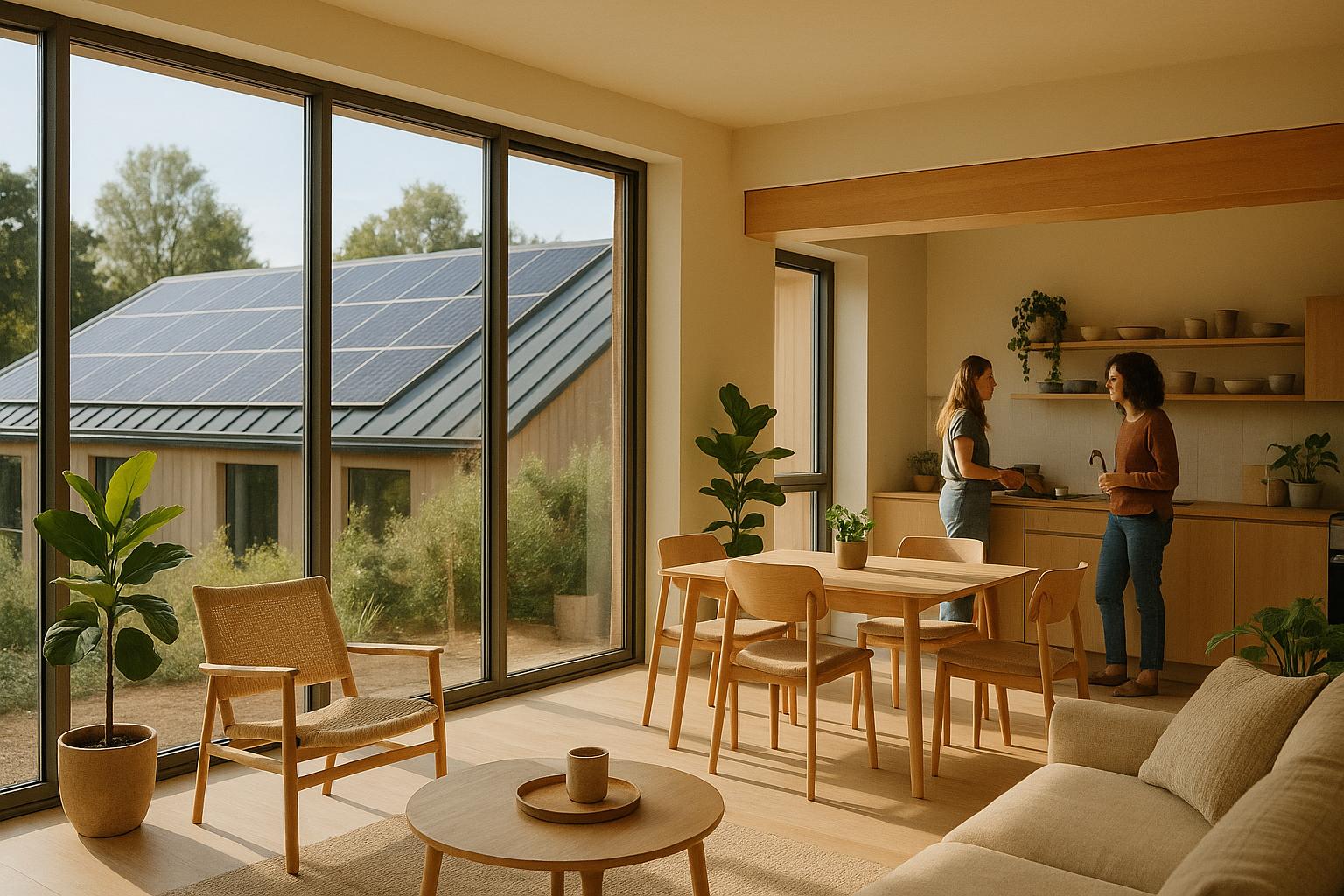Coliving spaces are transforming housing by offering affordable, flexible living options with shared amenities. Governments are now actively supporting these spaces to address rising housing costs, urban density challenges, and changing demographics. Here's a quick look at how coliving is making a difference:
- Affordable Housing: Coliving can cut housing costs by up to 40% compared to renting a studio apartment.
- Efficient Use of Space: Coliving houses more people in less space, reducing per-unit costs significantly.
- Zoning Reforms: States like Washington and Colorado are removing restrictions on shared housing, making coliving more accessible.
- Financial Support: Governments provide grants, tax incentives, and subsidies to encourage coliving projects.
- Green Incentives: Coliving developments often qualify for sustainability grants and tax breaks, reducing environmental impact.
Coliving isn't just a trend - it's a practical solution to housing shortages and affordability issues, with governments leading the way through policy changes and financial backing.
Policy Frameworks Supporting Coliving
Across the United States, governments are actively working to create policies that encourage the growth of coliving spaces. These initiatives aim to address long-standing regulatory challenges while establishing new standards that prioritize safety, affordability, and modern housing needs. By tackling issues like zoning restrictions, parking requirements, and sustainability, these reforms are opening the door for innovative housing solutions.
Zoning Reforms and Building Codes
One of the most impactful changes is happening in zoning laws. For years, restrictive zoning codes made shared housing and single-room occupancies almost impossible. But now, many states are reversing these outdated regulations to make coliving more accessible.
States like Washington, Oregon, Colorado, and Hawaii have passed laws that legalize microunits, remove limits on unrelated residents living together, and support coliving developments statewide. These changes have already had a noticeable impact. For example, in Seattle, coliving accounted for 1 in 11 new homes built between 2014 and 2016. Today, coliving homes in the city rent for an average of $1,027 per month, according to a 2023 real estate survey.
Colorado has taken bold steps by completely eliminating household size limits in 2024. Governor Jared Polis highlighted the broader significance of this policy, stating:
"This issue is both a housing issue and a civil rights issue." - Colorado Governor Jared Polis
Local governments across the U.S. and even in Toronto are also revising zoning codes that previously banned boarding houses and rooming houses. These updates allow coliving homes in urban areas where multifamily housing is already permitted, making it easier to integrate coliving into existing neighborhoods.
Parking and Transit-Oriented Adjustments
Parking requirements have been a major hurdle for coliving developments, as structured parking can add $25,000 to $65,000 per space to construction costs. To make coliving more viable, many governments are reducing or eliminating these mandates, especially near public transit.
Washington's SB 5184 is a standout example, capping parking minimums at 0.5 spaces per unit for multifamily buildings and removing parking requirements entirely for homes 1,200 square feet or smaller. Oregon has a similar rule, banning parking mandates for homes 750 square feet or less.
Transit-oriented development (TOD) strategies are also playing a key role in supporting coliving. For instance:
- New York City aims to have 95% of new housing within half a mile of mass transit.
- Los Angeles is targeting 57% of new housing units to be within 1,500 feet of transit stations by 2025.
Cities like Alexandria, Buffalo, San Antonio, and Chicago are adopting diverse approaches to parking reductions, ranging from 0.8 spaces per bedroom near transit to eliminating parking mandates entirely within 500 feet of transit stops. These changes have significantly cut development costs, sometimes saving up to $65,000 per parking space.
Green Building Incentives
Governments are also prioritizing environmentally friendly designs to support coliving spaces. With buildings contributing nearly 40% of global emissions, many programs now offer financial and regulatory incentives for sustainable coliving projects.
For example:
- Arlington, Virginia’s Green Building Incentive program allows developers to build larger structures if they achieve LEED certification. This "density bonus" can make coliving projects more financially appealing.
- King County, Washington provides grants for projects that meet strict resource conservation criteria, with additional benefits for those earning BuiltGreen™ certification.
- Portland, Oregon’s Green Investment Fund (GIF) supports initiatives focused on waste reduction, water conservation, energy efficiency, and renewable energy - all areas where coliving excels thanks to shared resources.
Financial incentives are especially attractive. Maryland offers a tax credit of up to 8% of a building’s total cost for green projects in priority funding areas. Similarly, New York State’s Green Building Tax Credit rewards owners and tenants who improve energy efficiency and indoor air quality.
Seattle City Light’s Energy Smart Services program takes it a step further, covering up to 70% of installation costs for energy-efficient upgrades. These programs often emphasize water and energy efficiency, healthy building practices, and resident engagement - areas where coliving can leverage shared spaces to reduce costs and environmental impact.
Government Subsidies and Financial Support
Beyond regulatory reforms, financial backing is a major driver in making coliving projects feasible. Governments often support coliving through direct funding, tax incentives, and partnerships with private entities. These financial tools play a critical role in determining which projects succeed, particularly in addressing rising housing costs and fostering stronger communities.
Direct Subsidies and Grants
Federal and state programs provide substantial funding to support coliving initiatives. The U.S. Department of Housing and Urban Development (HUD) leads many of these efforts, addressing housing shortages and promoting community-focused development.
One key program is HUD's Community Project Funding (CPF) Grants, which invest in housing, homelessness prevention, and essential infrastructure. These grants are well-suited for coliving projects that aim to meet local community needs, particularly in affordable housing.
For developments near public transit, the Innovative Finance and Asset Concession Grant Program (IFACGP), run by the U.S. Department of Transportation, is distributing $49.46 million to 45 local, regional, and state entities. Over 70% of these projects focus on transit-oriented and downtown redevelopment, with awards reaching up to $2 million. Notably, no matching funds are required for the first $1 million.
The Community Development Block Grant (CDBG) Program offers flexible funding for activities like housing rehabilitation, community center upgrades, and infrastructure improvements. These funds can be tailored to local housing needs while strengthening neighborhoods.
Rural areas also have access to resources through the USDA Community Facilities Direct Loan & Grant Program, which provides affordable capital for projects such as transitional housing and community centers. It covers up to 75% of eligible costs for rural communities with fewer than 5,000 residents.
Additionally, the HUD HOME Investment Partnership Grants Program allocates funds to states and localities to help nonprofit organizations build, purchase, or rehabilitate affordable housing. These grants can also provide rental assistance for low-income households, making coliving more accessible for those in need.
Tax Incentives and Abatements
While grants provide upfront funding, tax incentives help reduce long-term costs for coliving developers, particularly during building conversions.
For instance, New York City's RPTL 467-m program offers up to a 90% property tax exemption for up to 35 years for affordable housing conversions from commercial spaces. According to Development Site Advisors:
"cuts tax burdens on conversions, ensuring financial viability to repurpose office and commercial buildings"
into coliving spaces.
In Portland, Oregon, a tax abatement program can save property owners around $175 per month, or $2,100 annually - adding up to approximately $21,000 over 10 years. Additionally, dorm-style coliving designs can lower conversion construction costs by 25–35% compared to traditional apartment layouts.
Cincinnati, Ohio's Residential Tax Abatement Program allows property owners to pay taxes based on their property's pre-improvement value for 10 to 15 years. Properties meeting LEED or Living Building Challenge standards may qualify for extended abatements and higher benefits.
Syracuse, New York, provides a 10-year exemption from city and school taxes, with a 100% exemption on increased assessments for the first seven years. LEED-certified homes can enjoy extended benefits, aligning with coliving's focus on shared resources and environmental efficiency.
Public-Private Partnerships
Public-private partnerships combine government resources with private sector expertise to tackle housing challenges more effectively. These collaborations often lead to innovative solutions for coliving projects.
For example, Avanath Capital Management has teamed up with cities on several initiatives. In Boston, a joint effort converted market-rate housing into affordable units using grants and private financing. In Los Angeles, Avanath partnered with the Housing Authority of the City of Los Angeles (HACLA) and Kaiser Permanente to transform Baldwin Village into a 669-unit affordable housing community. Through HACLA's Innovative Partnerships Solicitation program, this project secured tax abatements to convert 70% of the units to affordable housing.
In Detroit, Avanath is working with the city and private firms to develop a 177-unit mixed-income property on formerly vacant land. This project complies with Detroit's Inclusionary Housing Ordinance by designating 20% of units as affordable, with a focus on senior housing.
San Francisco's HOPE SF Project is another example of a successful public-private initiative. This collaboration between the city, nonprofits, and private developers aims to revitalize public housing through mixed-income developments. Over 1,000 housing units have already been built, with more in the pipeline.
New York City's Housing New York Plan has leveraged public-private partnerships to create and preserve affordable housing. By offering tax incentives and zoning bonuses, the initiative has led to the construction of over 60,000 new units and the preservation of more than 130,000 existing ones.
Smaller-scale efforts also highlight the potential of these partnerships. For instance, the City of High Point used $650,000 in Section 108 funds to secure $10.4 million in private capital for Avondale Trace, a 72-unit affordable housing project. Similarly, Brewster Woods in Massachusetts combined funding from various sources, including a $1.68 million MassWorks grant, to clear land and improve infrastructure.
These examples show how public and private collaboration can expand housing access and lower costs, making coliving a viable option for more communities.
Case Studies: Government Initiatives That Work
Real-world examples highlight how government policies have successfully promoted coliving as a solution to local housing challenges.
Washington State
Washington State has taken bold steps to support coliving through progressive legislation. A standout example is House Bill 1998, which gained bipartisan approval. This law legalized coliving across the state and requires cities and counties under the Growth Management Act to permit coliving wherever six or more multifamily residential units are allowed.
"This bill unlocks the potential to provide much-needed affordable housing options for countless Washingtonians", said Rep. Mia Gregerson (D-SeaTac).
Building on earlier efforts like H.B. 1042 - which facilitated office-to-housing conversions - Washington has also tackled development hurdles. For instance, Senate Bill 5184 limits parking requirements for multifamily buildings to just 0.5 spaces per unit, and eliminates them entirely for units under 1,200 square feet. Meanwhile, House Bill 1491 encourages development near transit with funded inclusionary zoning, and H.B. 1096 allows homeowners to subdivide their lots.
These measures have significantly reduced construction costs. For example, converting office buildings into microunits with shared amenities costs about $190,000 per unit - less than half the $400,000 needed for a traditional studio apartment.
Seattle Mayor Bruce Harrell emphasized the practical benefits:
"To bring down housing costs and serve residents at all stages of life, Seattle needs more housing and a more diverse range of housing options. Removing barriers to developing co-living and congregate-style residences is a commonsense way to increase housing supply and diversity in neighborhoods that have great access to jobs, transit, and other amenities."
Other regions are also finding ways to adapt existing spaces for coliving, such as Hawaii’s approach with vacant commercial properties.
Hawaii
Hawaii has embraced the potential of repurposing unused office spaces for coliving under House Bill 2090, which allows vacant offices and other commercial buildings to be turned into microunits statewide. This opens the door for more coliving developments while addressing the state’s underutilized commercial real estate.
On Oahu alone, 13% of office spaces sit empty. H.B. 2090 removes red tape that previously hindered such conversions, and it also reduces parking requirements for these projects, recognizing that shared housing residents often have different transportation needs.
By reusing existing infrastructure, Hawaii creates ffordable coliving spaces faster and at a lower cost than constructing entirely new buildings.
Washington, D.C.
Washington, D.C. demonstrates how local governments can boost coliving through financial incentives and zoning reforms. In the city, coliving rents average around $1,000 per month, making it an attractive option for young professionals, students, and others facing high housing costs.
The city has streamlined approval processes and adjusted zoning rules to accommodate shared housing. These changes lower development costs and speed up project timelines. Additionally, D.C. promotes the conversion of existing commercial and residential spaces into coliving units, broadening the range of available properties.
Senator Jesse Salomon highlighted the impact:
"This bill offers people more options for affordable housing. Not everyone is best served by a focus on single family homes. Because the rental price point is low, this will help young people live in high-demand areas like Capitol Hill and will help retirees create communities amongst themselves."
These examples showcase how thoughtful government policies can make coliving a practical and affordable housing solution across the country.
Benefits of Coliving Spaces
Governments are increasingly recognizing the advantages of coliving, offering revised zoning rules and financial incentives to encourage its growth. These efforts highlight the broad benefits coliving provides to residents, communities, and the environment.
Affordable Housing and Community Building
Coliving spaces address the housing affordability crisis by lowering costs through shared resources and efficient use of space. For instance, in cities like Los Angeles, Houston, and Denver, coliving can reduce monthly rent by nearly half compared to median rates, offering substantial savings.
By sharing communal areas, which typically account for 25%-30% of the total space, coliving reduces individual housing expenses. These costs often include utilities, furnishings, security, cleaning, and no move-in fees, making coliving an attractive option.
"The fact that these rents are 'all in' monthly costs (including water, electrical, furnishing, security, cleaning, and no move-in cost) make the product particularly attractive as compared to other low cost and market-rate product(s)", says Wes LeBlanc, Principal and Strategy Director at Gensler.
Additionally, converting spaces for coliving is more cost-effective. Conversion costs are up to 35% lower than traditional office-to-residential projects. A study by Pew Charitable Trusts found that public subsidies can fund two to four times more coliving units compared to standard apartments.
"In each city we've studied, local governments could create far more housing with their subsidy dollars using this model than with conventional apartments", notes Alex Horowitz, Project Director of the Housing Policy Initiative at The Pew Charitable Trusts.
For example, in Los Angeles, coliving conversions require $120,000 in subsidies per unit, far less than the $380,000 needed for traditional studio apartments. This not only stretches public funds but also aligns with environmental goals by reducing per-person resource consumption.
Environmental Benefits
Coliving supports sustainable urban living by making better use of land and shared resources. With more residents accommodated per square foot, these spaces help curb urban sprawl and protect green areas.
Shared amenities like heating, cooling, and lighting lower per-person energy use, while many coliving spaces incorporate eco-friendly features such as solar power to minimize their carbon footprint.
Community-driven sustainability efforts are also common. Shared transportation options reduce reliance on cars, while initiatives like community gardens and recycling programs encourage collective environmental responsibility, often achieving more than individual efforts in traditional housing setups.
Support for Different Groups
Coliving isn’t just about affordability and sustainability - it also meets the needs of students, remote workers, and entrepreneurs by offering furnished, flexible housing with built-in community amenities.
For students and young professionals, coliving eliminates the need for costly furniture purchases. Flexible lease terms align with academic schedules, internships, or job changes, while the community aspect helps newcomers build social networks in unfamiliar cities.
Remote workers benefit from features like coworking spaces and high-speed internet, which enhance productivity while combating the isolation often associated with working from home.
Entrepreneurs and career changers appreciate the lower financial risk and networking opportunities that coliving provides. The growing availability of coliving spaces in recent years underscores its role as a modern, practical housing solution.
Finding and Accessing Coliving Spaces
Government initiatives have made it easier to find coliving opportunities through specialized platforms and local resources. Whether you’re searching for subsidized housing or market-rate coliving spaces, there are plenty of strategies to help you locate options that suit your budget and lifestyle. Tools like Coliving.com have become a go-to resource for many.
Using Platforms Like Coliving.com
Coliving.com offers access to 38,000 rooms in 1,900 coliving spaces spread across 380 cities and 70+ countries. The platform simplifies the process, from browsing options to booking, making it particularly useful for finding affordable coliving spaces, including those supported by government programs.
You can refine your search by location, price, room type, dates, and amenities. For budget-friendly options, try search terms like "coliving near me," "coliving community," or "coliving apartments." If you’re looking for something specific, such as spaces tailored for remote workers or students, search phrases like "coliving for digital nomads" or "coliving for students" can help narrow down your options.
The platform’s online process makes it easy to sidestep traditional rental headaches. Features like online rental agreements and streamlined bookings save time and effort. With prices starting as low as $100 per month, many listings include utilities, Wi-Fi, and cleaning services - elements that align well with government programs aimed at reducing living costs.
Coliving.com also offers flexible cancellation policies and a money-back guarantee, which is a huge plus for students, remote workers, and young professionals who need financial flexibility.
Features and Advantages of Coliving Platforms
Platforms like Coliving.com provide a variety of tools to help you make informed decisions. Clear photos, virtual tours, and resident reviews give insight into everything from cleanliness to community events and maintenance responsiveness - details that can make or break your living experience.
One standout feature is transparent pricing. Unlike traditional rentals, platforms often display all-inclusive rates, with any extra fees clearly outlined. This allows users to budget more accurately and compare options, especially when weighing government-subsidized spaces against market-rate alternatives.
Flexible lease terms are another perk, catering to individuals with short-term needs, such as students, interns, or those transitioning jobs. These features often align with government housing programs designed to serve a variety of populations.
If online platforms don’t meet your needs, government-connected resources can also help. Programs like Local Public Housing Agencies (PHAs) manage public housing and Housing Choice Vouchers, which may sometimes apply to coliving arrangements. Additionally, HUD-approved housing counselors can guide you through available options tailored to your area and circumstances.
Municipal Comprehensive Plans often highlight housing strategies, including coliving and home-sharing options. Reviewing these plans can uncover local initiatives or upcoming developments that might be relevant to your search.
Some cities also run home sharing programs, which connect people with extra space to those in need of affordable housing. For example, HIP Housing in San Mateo County, California, has been running a Home Sharing Program since 1979. This initiative primarily helps older adults rent out unused rooms, providing affordable housing for tenants while helping homeowners cover property taxes and maintenance costs. HIP Housing also offers screening and mediation services to ensure smooth arrangements.
"In our area, we are trying to make it an assumption that this is what everybody does here", says Kate Comfort Harr, Executive Director of HIP Housing.
In another example, Jefferson County in the Denver area has adopted a collaborative approach, working with housing authorities, community development departments, and local organizations. They’ve supported projects like renovating a senior’s basement to create a livable space for a homeless individual, while also connecting them to workforce training and childcare resources.
For broader guidance, the National Shared Housing Resource Center provides tools and advice on setting up home-sharing programs. These government-backed resources often lead to affordable coliving options that might not appear on commercial platforms, offering a valuable alternative for those seeking cost-effective housing solutions.
So, what does this mean?
Government-supported coliving initiatives are proving to be a practical response to America's housing crisis, with real progress already visible across the country. For instance, Washington's HB 1998 has the potential to create over 2,400 affordable units annually. Similarly, Chicago's $151 million plan is transforming office buildings into 1,000 housing units, with 319 designated as affordable. Converting office spaces into microunits costs approximately $190,000 per unit - less than half the $400,000 typically needed for a traditional studio apartment. This cost efficiency means public funds can stretch much further, producing two to four times more coliving units than conventional apartments. Considering the U.S. faced a staggering 3.8 million housing unit deficit by 2020, these conversions are making a meaningful impact. As discussed earlier, zoning reforms and targeted financial support play a critical role in these successes, pairing economic savings with broader environmental and social advantages.
Coliving doesn't just increase housing supply - it brings additional benefits. These spaces can cut carbon emissions by 32% compared to single-family homes, while also fostering a sense of community that helps combat loneliness - a challenge faced by 27% of young adults aged 19–29. With the coliving market projected to grow to $9 billion by 2025 and as many as 36.2 million Americans expected to work remotely, government involvement is key to addressing these shifting housing demands.
Recent policy changes are further driving coliving growth. Starting in January 2025, Los Angeles will implement updates to its Citywide Adaptive Reuse Ordinance, simplifying approvals for repurposing older buildings. Similarly, Seattle has introduced legislation, effective February 2025, that offers tax deferrals for commercial-to-residential conversions. These measures, paired with reduced parking requirements and updated zoning rules, are creating an environment where coliving projects can flourish.
The early success of these government-backed initiatives highlights how policy can effectively tackle housing affordability while encouraging sustainable urban development. As more cities embrace these strategies, coliving will continue to expand, offering affordable, community-focused housing solutions for students, remote workers, and young professionals alike.
FAQs
How do zoning reforms influence the growth and availability of coliving spaces?
Zoning reforms significantly influence the expansion and accessibility of coliving spaces. By permitting a broader range of housing types, reducing minimum lot size requirements, and removing parking mandates, these adjustments cut development costs and pave the way for more diverse housing options, including coliving arrangements.
That said, cities must also confront the lasting impact of discriminatory zoning practices like redlining to ensure housing equity. Integrating policies that promote fairness can help build more inclusive neighborhoods, making coliving spaces available to individuals from all walks of life.
What financial incentives are available in the US for developing sustainable coliving spaces?
Developers in the US have access to various financial incentives aimed at promoting eco-friendly coliving spaces. One example is the 45L Tax Credit, which provides up to $5,000 per energy-efficient unit to reward environmentally conscious housing designs. Beyond tax credits, developers can also explore green bonds and sustainability-linked loans, both of which offer funding tailored for real estate projects with a focus on environmental responsibility.
These initiatives not only help minimize environmental impact but also encourage the development of forward-thinking, sustainable coliving communities.
How do public-private partnerships help grow coliving spaces as a housing option?
Public-private partnerships (PPPs) are crucial in growing coliving spaces by bringing together government resources and private sector expertise. These partnerships often involve incentives like subsidies or tax breaks, which help make coliving projects more accessible and financially viable.
By tackling housing shortages and affordability issues - especially in urban areas - PPPs pave the way for coliving spaces that align with today’s lifestyles. These collaborations focus on creating housing solutions that emphasize community, convenience, and flexibility, making coliving an appealing and practical choice for many people across the U.S.






